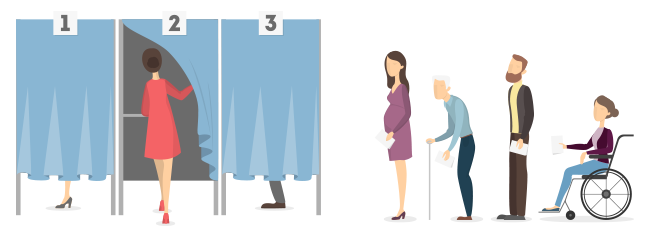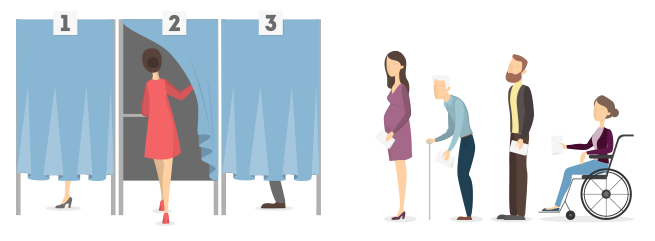Voting
Los Angeles County Mock Election Vote Center Monitoring Report Fall 2019
November 14, 2019
Disability Rights California (DRC) and Asian Americans Advancing Justice - Los Angeles (Advancing Justice-LA) collaborated to conduct vote center monitoring and voter outreach during the Los Angeles County Mock Elections on September 28th and 29th, 2019.
The primary objective was to gather community feedback and identify potential issues arising from changes to the voting system that the county is implementing for the 2020 election cycle.
For this project, DRC and Advancing Justice-LA created an exit survey to collect voter feedback about their voting experiences, and a questionnaire to gather observations (i.e., set-up, check-in, and voting process) made by volunteers and staff at vote centers. In anticipation of robust voter participation, including those with limited English proficiency (LEP), surveys were translated into four languages: Chinese (Traditional and Simplified), Korean, Tagalog, and Spanish. DRC and Advancing Justice-LA recruited and trained volunteers to conduct the monitoring and surveying of vote centers during the mock election.
Leading up to the mock elections, 16 locations were identified to be high-priority based on demographic analyses. Three of these high-priority locations were covered for the entirety of both days, seven for at least one full day (10AM - 4PM), and six for at least half a day (10AM - 1PM or 1PM - 4PM). In total, 64 volunteers gathered nearly 700 exit surveys over 294 hours of elections at 24 sites. Staff from DRC and Advancing Justice-LA also visited and observed an additional 23 locations for 30 to 45 minutes. In total, between the volunteers and staff, 47 locations were covered over the span of two days.
1.
Voter turnout across surveyed vote centers was low.
Along with numerous vote center workers, many of our volunteers reported very low turnout throughout the weekend. One team even reported encountering zero voters during their shift.
2.
Voters were receptive to the new Ballot Marking Device (BMD).
The vast majority of survey respondents indicated that the BMD was easy to use and did not mention any issues that were substantially prohibitive to voting.
3.
Poor placement of Ballot Marking Devices impacted accessibility and privacy.
Although it varied across the sites, the placement of the BMD machines often did not effectively use the space available. BMDs were sometimes too closely placed, such that individuals were able to read neighboring screens or that accessibility was or could become difficult for voters with disabilities who use mobility devices, such as wheelchairs, scooters or walkers.
4.
Voters suggested more and improved instructions on how to use the BMD.
Some voters were confused about how to use the BMDs and felt that there was insufficient instruction from vote center workers or otherwise. They recommended making available some sort of how-to or instructional video/demonstration beforehand.
5.
Small sample size of LEP voters resulted in limited data analysis.
In total, only 50 (7%) of the exit survey respondents voted in a non-English language. By and large, these voters were able to successfully vote in the language of their choice, though, responses were mixed regarding the quality of the translation and as to the ease of BMD use.
6.
Voters with disabilities identified a few accessibility challenges.
Several respondents who self-identified as having a disability encountered problems with the audio headset, namely that it had a low volume output and was not readily available for use. Some voters suggested providing chairs, as people such as seniors and people using walkers found it physically challenging to be standing throughout the entire voting process. Several vote center workers seemed unaware of the various required accessibility features, such as magnifying glasses or signature guides.
7.
Signage was inadequate.
Many reported that signs directing people to and identifying the vote centers were insufficient and in need of improvement. Although signs were posted around the vote centers, the signs were not large enough or did not extend far enough to notify and direct voters effectively. This was especially so at sites within large spaces or where the parking areas did not directly lead to the vote center.








